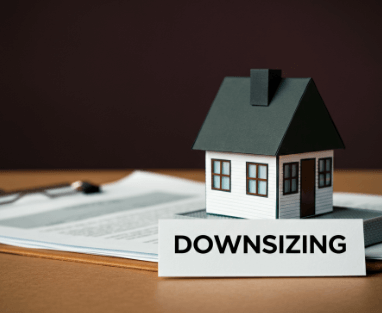Deciding when to downsize your house can be as challenging as it is critical, especially for those navigating significant life changes or looking to simplify their lifestyle. Our latest blog post offers “10 Tips on Knowing When to Downsize Your House,” a comprehensive guide designed to help homeowners recognize the right time to make this significant move. Whether due to retirement, the kids moving out, or simply a desire for a more manageable living space, understanding when to downsize your house is crucial for making a transition that aligns with your goals and needs. Explore with us the fundamental elements and practical advice to ensure that your decision to downsize is made with confidence and clarity.
Steve Daria and Joleigh, esteemed real estate investors, advocate recognizing when to downsize your house. They emphasize that significantly reducing maintenance tasks and costs can indicate it’s time to consider a smaller residence. Leveraging their expertise, they also point out that changes in lifestyle, such as retirement or children moving out, often signal the opportune moment for downsizing.
Knowing When to Downsize Your House
Recognizing the right moment of knowing when to downsize your house can significantly impact your lifestyle and financial health.
It often involves assessing changes in family size, financial goals, and personal needs.
Downsizing might be the right move if you find yourself with more space than you use, facing financial pressure from upkeep costs, or seeking a simpler lifestyle.

Additionally, many choose to downsize to free up equity for retirement, reduce living expenses, or move closer to loved ones.
Grasping these factors can empower you to make a well-considered decision, ensuring that downsizing aligns with your life stage and plans.
1. Understanding the Meaning of Downsizing
Before we plunge into the practicalities of when to downsize your house, we must grasp the meaning of downsizing.
It’s more than a reduction in square footage; it’s a conscious decision to streamline your life by simplifying your living arrangements.
This can involve shedding material possessions, reducing household maintenance, lowering bills, or all of the above.
Downsizing is an intentional act that allows for a more focused, often more accessible, way of living.
By understanding the core of this transition, you set the stage for an empowering move that aligns with your evolving needs.
2. The Financial Forefront: When to Downsize for Economic Reasons
Fiscal prudence often catalyzes the downsizing decision. Life’s ebb and flow mean your financial circumstances may vary.
Downsizing can be a savvy move to gain control over your finances, particularly if you’re approaching retirement or have experienced a reduced income.
Consider downsizing when it provides an opportunity to:
- Use home equity to fund retirement or investment goals
- Eliminate or significantly reduce mortgage payments
- Lower property taxes and insurance costs
- Decrease energy and maintenance expenses
In volatile economic times, the rightsizing move can stabilize your budget, enabling you to allocate resources strategically.
3. Sizing Up Your Lifestyle Needs
A significant driver for many in the downsizing process is the quest for a lifestyle that reflects their present life phase.
Your current home may no longer cater to your way of living, your hobbies, or your plans.
Here’s when to downsize your house:
- Empty nesters may find that a large, family-oriented home no longer meets their needs.
- Health concerns might warrant a move to a more accessible space, such as a one-story residence or a home within a retirement community.
- The desire for convenience, community, or closer to urban centers might inspire a shift to a smaller, more centrally located dwelling.
Get An Offer Today, Sell In A Matter Of Days
4. Emotional Cipher: Addressing Nostalgia and Attachment
The emotional dimension of downsizing is often the most challenging to reckon with. Your home is a repository of memories; parting with it can evoke a sense of loss.
Yet, it’s important to distinguish between the physical structure of your dwelling and the essence of home, which transcends walls and rooms.
Understand that letting go of the material is not letting go of the memories. Downsizing can help distill the most cherished elements of your living space.
With this perspective, you can approach the process with a mindset of preserving what truly matters while divesting the extra.
5. Tips for Tackling Downsizing Décor and Furniture
One of the most tangible aspects of downsizing is managing your décor and furniture.
Oversized pieces that once anchored your living room might not fit in your new, more streamlined abode.
Here’s how to handle this aspect with finesse:
- Start early and work in incremental phases to give yourself sufficient time to sort through your belongings.
- Be methodical in your approach, categorizing items into those you’ll take, sell, donate, or discard
- Measure doorways and new living spaces to ensure your essentials fit their new home.
By thoughtfully curating your possessions, you ensure that what remains serves a purpose and brings joy, harmonizing with your downsized lifestyle.
6. The Art of Selling and Donating
Monetizing your assets through selling and the philanthropic act of donation is a two-fold benefit of downsizing.
It helps finance your move or boost your savings and allows others to enjoy what you no longer need.
These practical tips can optimize your selling and donation process:
- Research the value of your items, especially if they’re of high worth or historical significance
- Please choose the appropriate selling platform, whether it’s a garage sale, consignment shop, or online marketplace
- Understand tax implications for charitable donations and keep meticulous records of the items you give
By approaching the sales and donation stage efficiently and compassionately, you can transform your extra belongings into meaningful contributions or financial resources for your next chapter.
7. Choosing the Rightsize Home
The crux of the downsizing decision lies in choosing a home appropriately scaled to your current needs.
This might mean finding a townhouse that offers a modest yet comfortable living space, a cozy beach cottage, or a chic city apartment.
To select the correct size home, factors to consider include:
- The number of bedrooms and bathrooms necessary for your household
- The presence of multipurpose rooms that can adapt to changing needs
- Proximity to amenities and services that are vital to your lifestyle
- The overall layout and design of the home ensure it meets your perfect functional and aesthetic preferences
By vetting potential new residences against these criteria, you can make an informed choice that supports your downsizing goals.
8. Mastering the Moving Process
The logistics of moving from a larger home to a more compact one can be daunting, but a strategic approach can ease the transition. It’s critical to:
- Hire reputable movers with experience in downsizing relocations.
- Secure packing materials that protect your valuables during transit
- Label boxes clearly to simplify the unpacking process.
- Organize your move according to a detailed timeline, accounting for all essential tasks leading up to and following the moving day.
With these measures, you can ensure that your downsizing move is as smooth and stress-free as possible, allowing you to focus on the exciting new chapter ahead.

9. Creative Storage Solutions for the Downsized Dwelling
The storage question becomes paramount once you’ve settled into your new, cozier home. Efficient storage solutions are vital to maintaining an organized and comfortable living space.
Consider these creative strategies:
- Invest in multifunctional furniture with built-in storage, such as ottomans or bed frames with drawers
- Utilize vertical space with shelves and wall-mounted organizers
- Seasonally rotate items to storage units or custom-built closets to maximize living space
By creatively utilizing every available corner, you can ensure that even in a downsized home, every item has its place, and your living space needs to be more functional and functional.
10. Life After Downsizing: Adjusting to Your New Home
The period after you’ve downsized is one of adjustment and acclimation. Give yourself the grace to adapt gradually to your new surroundings.
Here are some tips for this final phase of the downsizing experience:
- Consider redecorating your new home to create a fresh, harmonious environment.
- Engage in local community activities to establish a network and sense of belonging in your new locale.
- Monitor your satisfaction with the downsizing decision, making adjustments as necessary to ensure that the move continues to serve your best interests.
By being deliberate in your approach to life after downsizing, you set the stage for a future aligned with your evolving priorities and preferences.
In conclusion, knowing when to downsize your house involves judicious financial, lifestyle, and emotional evaluation. Through the tips in this compendium, you gain a 360-degree perspective on the downsizing process, from ideation to execution, ensuring that your transition is marked by clarity, purpose, and a renewed sense of home. Embarking on a downsizing journey is a testament to your adaptability and foresight—the proper guidance can lead to a life that is rightly sized for your happiness and fulfillment.
**NOTICE: Please note that the content presented in this post is intended solely for informational and educational purposes. It should not be construed as legal or financial advice or relied upon as a replacement for consultation with a qualified attorney or CPA. For specific guidance on legal or financial matters, readers are encouraged to seek professional assistance from an attorney, CPA, or other appropriate professional regarding the subject matter.

